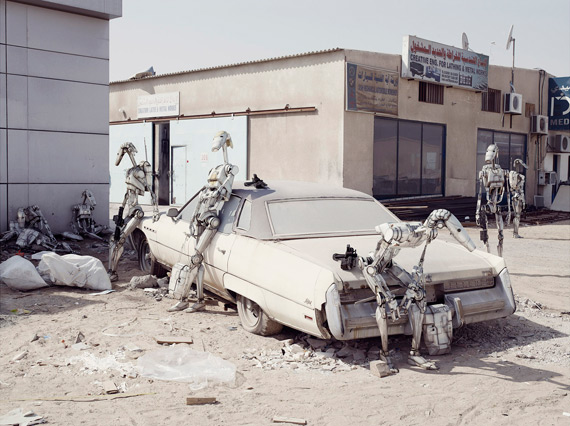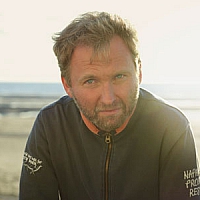
The Empty Quarter Gallery Gate Village, Bldg 02 P.O.BOX 506697 Dubai Émirats arabes unis
"..perhaps one might only half-jokingly suggest that people build cities today in order to live inside science fiction films."
Geoff Manaugh, BLDGBLOG
What is this entity that is known to the world as Dubai? An invented city? A large-scale congregation of architecture in urban form? A real home to 1.5 million people?
The recent photo works of Cedric Delsaux, the final installment of his Dark Lens trilogy dealing with the fact and fiction of modern urban space, can be viewed as an attempt to approach this enigmatic, emblematic city, using cinematic futurism as a tool to get a grasp on the present. Cedric describes the feeling he had as if walking around in a gigantic set for a science fiction film: "I instantly knew that all the characters from the Star Wars galaxies would be at home here." Seen through his Dark Lens, Dubai appears to be finally welcoming the guests it has been built for from the beginning.
Delsaux collapses the realm of fiction and the realm of the real onto a single image plane: film characters are inserted into photographs of existing locations that often appear less real than the iconic crew and vehicles of the Star Wars films, whose adventures we have witnessed with our own eyes on screens around the globe. What the artist aims for is not a photographic rendering of the raw reality of Paris, Lille, and now Dubai, but an exploration of the dream potential these cities hold within. He feels we are unable to truly see the world that surrounds us; we can only ever have a perception of it, filtered through the prism of our own culture, history, our sensitivity. Cedric explains: "Since I cannot convey reality, I'll show the perception, the fiction, I have of it." Simultaneously facetious game, dark joke and mise en abyme, Cedric Delsaux has developed what he calls "an aesthetic of the in-between", inextricably interweaving fantasy with real objects. This new world, accurate, swarming with objective details, is absolutely false, yet totally truthful in so far as it reveals the essentially retro-futuristic characteristic of modern urban spaces, which are simultaneously too early and far too late.
However tempting, the work of Delsaux ought not be reduced to a mere game of digital manipulations that tap into the visual language of commercial advertising and myth-making film history. Despite moving in the territory shared by both film and advertising, Cedric Delsaux's work remains firmly rooted in contemporary landscape photography. The starting point of his Star Wars trilogy was a project exploring the nature of urban architecture, called La Vitrine des Choses, set in the north of France. Cedric recounts: "I photographed ordinary places, warehouses, harbours and houses that I tried to render extraordinary by setting them in a particular frame and experimenting with lighting. I continued this project in the suburbs of Paris, but realized there was something missing, since the images no longer seemed that extraordinary. It was at this point that I decided to introduce sci-fi characters. Star Wars was a part of my childhood like many kids my age, but I wasn't a fan. It wasn't necessarily my chosen genre - nevertheless, the power of Star War films overtakes the sci-fi genre by a mile."
The insertion of sci-fi characters was to be the key to a hidden door of perception, transforming our quotidian surroundings into places where anything might happen. For instance, travelling around Dubai after seeing this exhibition will never be the same again. One day you may find yourself looking up at the sky, expecting to see speeder bikes chasing each other around the Burj Tower, only to realize you were fooled for a second by the sound of traffic around you. Rejoice and shiver, imagination has invaded everything.

